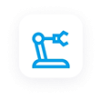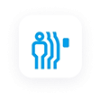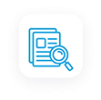The Port of Rotterdam is the first port terminal in the world to embrace automation. It was in 1993. Today, the Port of Rotterdam is one of the most fully automated ports in the world. Some of the prominent automated ports in the world include Qingdai (QQCTN), Yangshan, Ningbo Zhousan in China, and the Port of Melbourne in Australia. QQCTN and the Port of Melbourne became fully automated by 2017.
The global container shipping scenario drastically changed in 2020 with the arrival of the COVID-19 pandemic. As a result, the trade volume of international container shipping came down, and the focus has been shifted to the development of automated ports or smart ports. This shift has been powered by technologies such as Global Positioning System (GPS), Laser Sensor Technology, Light Detection and Ranging (LiDAR), and 5th Generation internet (5G).
Port automation can be defined as the automation of cargo handling activities at the port or logistics center. Automation refers to transferring manual labor to autonomously operating machines like Automated Guided Vehicles (AGVs) and Autonomous Mobile Robots (AMR).
The international automated ports market is projected to reach nearly $6 billion by 2027 from an estimated $2 billion in 2022, at a Compound Annual Growth Rate (CAGR) of 24.3% during the forecast period. This impressive growth is driven by various factors. Some of them are listed below.
- An increase in international maritime trade activities.
- International pressure to decarbonize the maritime industry.
- The surge in the use of real-time geospatial data to enhance port operations.
- Increasing Industry 4.0 adoption to improve the efficiency of ports.
Laser sensor technology plays a crucial role in port automation, making ports smarter, safer, and more efficient. This article discusses how ports can benefit from this technology.
The Benefits of Using Laser Sensor Technology in Port Automation
Laser sensor technology is becoming a valuable component of port equipment and autonomous vehicles, helping to enhance their reliability and predictability. A few essential benefits of this technology are listed below.
Increased Efficiency and Productivity
Laser sensor technology can be integrated with various autonomous vehicles and machines, including Automated Guided Vehicles (AGVs) and Internal Terminal Vehicles (ITVs), which operate within the port. These machines are involved in cargo handling, container stacking, and cargo tracking.
Without laser sensor technology, ITVs and AGVs need to be operated manually. It would be a time-consuming, labor-intensive, and risky process. Therefore, laser sensor technology can increase the speed and accuracy of cargo handling, leading to increased efficiency and productivity. Different laser sensor technology products, such as laser distance sensors, obstacle detection scanners, and LiDAR, can be used for efficient and productive port automation.
Improved Safety and Security
Hundreds of containers must be safely moved at ports, while people and heavy machinery must work closer. In such a scenario, numerous safety risks exist, and an automated port is always a safer solution.
It is possible to integrate laser sensor technology in an Automatic Stacking Crane (ASC) or Ship-to-Shore (STS) crane, automating the loading and unloading of containers. In addition, the sensor can precisely locate and profile a container and efficiently pick up and store it using less space. Furthermore, rubber Tyre Gantry cranes (RTGs) with LiDAR sensors enable safer navigation and collision avoidance.
Port automation using laser sensor technology improves worker safety by automating dangerous tasks and reducing the risk of human error. On top of that, it enhances security by providing real-time cargo monitoring and tracking, preventing theft or loss.
Cost Savings and Environmental Benefits
By reducing manual labor, laser sensor technology can save operating costs and increase cargo handling efficiency. In addition, it can bring environmental benefits by reducing emissions and energy consumption.
For instance, the Shandong Port Group Co, Ltd. implemented 3D-LiDAR scanners in 2021, which brought down 90% of workplace accidents and 25% of operation costs and losses.
Optimize Port Operations with Laser Sensor Technology from Hokuyo
Partial or complete port automation has been catching up globally owing to its increased cost savings, enhanced productivity, and low cost of implementation. As supply chain systems worldwide get back into active mode, port operators should implement laser sensor technology.
Different sensor products like obstacle detection scanners, LiDAR and laser distance measuring sensors help you optimize operations and reap the benefits of port automation with laser sensor technology.
Hokuyo offers laser sensor technology products of the future with compact designs that can perfectly fit your port, factory, process automation industry, or your function specifications.
Get in touch with us to learn more.

 Factory Automation
Factory Automation Logistics Automation
Logistics Automation Process Automation
Process Automation Crane Collision Avoidance
Crane Collision Avoidance LiDAR Sensors
LiDAR Sensors Safety Laser Scanners
Safety Laser Scanners Optical Data Transmission
Optical Data Transmission Hot Metal Detectors
Hot Metal Detectors Laser Distance Sensor
Laser Distance Sensor Blog
Blog Whitepapers
Whitepapers Case Studies
Case Studies Infographics
Infographics